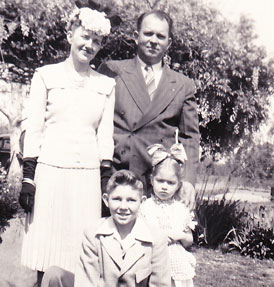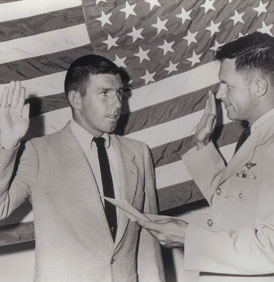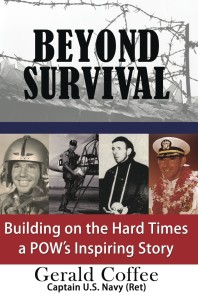BEYOND SURVIVAL BUILDING
ON THE HARD TIMES A POW’S INSPIRING STORY
U.S. Navy (retired) Captain Gerald Coffee flew low-level reconnaissance missions over Cuba during the Cuban Missile Crisis, which provided photographic proof of Soviet nuclear-tipped missiles, turning the tide of the dangerous Soviet – U.S. standoff. During the Vietnam War, Jerry was flying a combat mission off the USS Kittyhawk when he was shot down by North Vietnamese anti-aircraft guns. Immediately captured, he was held prisoner for over 7 years in the infamous ‘Hanoi Hilton’ communist prison where torture and solitary confinement were routine. His book, Beyond Survival, describes his experiences in gritty detail and his keynote talk has inspired thousands worldwide with a message of hope, faith, courage, and honor.
CHILDHOOD AND EARLY CAREER


In 1957, Jerry married his high school sweetheart Bea Bispo after her graduation from San Jose State, the couple would have four children: Kimberly, Steven, David, and Jerry Jr. After his graduation he entered the Navy and began pre-flight training in Pensacola, Florida in the fall of 1957.
In August 1959 Jerry received his Navy wings and began flying photo Crusaders (RF-8As) out of Cecil Field, Florida. During this time he deployed twice on the the aircraft carrier USS Saratoga, making ports of call at Barcelona, Spain; Cannes, France; Beirut, Lebanon and several Italian ports as well. He accrued over 200 carrier landings while on the Saratoga.
CUBAN MISSILE CRISIS

In a Cold War Era world where communism was ever encroaching, America could not allow an armed Soviet adversary so close to home. Grainy photographs from high-flying U2 aircraft had already recorded the presence of Soviet missiles in the mountainous Cuban countryside, but further proof was needed to convince the UN and the world.
Coffee and his lead plane flew at incredibly low altitudes at speeds of 460 miles per hour while remaining stable to take clear photos. During one mission Captain Coffee pulled away from his preplanned route after seeing a military encampment and motor pool and took just one more strip of photos before heading back to base in Florida. These photos showed, for the first time, that Cuba had mobile, nuclear-tipped Soviet surface-to-surface missiles or FROGs (Free Rockets Over Ground), which could have decimated a conventional amphibious landing force. These photos caused the U.S. Marines to change their contingency strategy, and, quite conceivably, change the course of world history. The photos would become a key piece of evidence to end the Cuban Missile Crisis.
Additionally, his photos were among those used as solid proof of Soviet strategic weapons (IRBMs) Intermediat Range Ballistic Missiles on Cuba by Adlay Stevenson, the U.S. ambassador to the United Nations. Ultimately President John F. Kennedy made a deal with Khrushchev that if the Soviet Union removed all missiles, the U.S. wouldn’t invade the island, and would also withdraw their obsolete Jupiter missiles from Turkey.
VIETNAM

On February 3, 1966 Coffee and his navigator Lt. Robert Hanson flew an intelligence-gathering mission in a heavily defended portion of North Vietnam when they were hit by enemy anti-aircraft fire. Coffee attempted to get the plane as near to the Kittyhawk as possible but lost control of the plane due to a damaged hydraulic control system. Both he and his crewman ejected from the rapidly spiraling aircraft over the gulf, just off the shore of the Nghe An Province 60 miles south of Hanoi.
Both men safely ejected, though Coffee suffered a concussion, dislocated shoulder and knees, a broken forearm and many cuts and burns due to the high-speed ejection. They were almost immediately captured by the North Vietnamese. U.S. planes then strafed the North Vietnamese who had captured Coffee, not realizing Coffee and Hanson were among them. It is possible that Lt. Robert Hanson died by “friendly fire”during this attack.

While communicating with other P.O.W.s who were kept in the prison was a punishable offense, Coffee made contact with other shot-down American airmen through an established “tap-code” or a matrix of coded letters of the alphabet through tapping combinations on the wall between cells. By using Tap Code, the P.O.W.s established for themselves a military chain of command that enabled senior officers to create a formal resistance posture to the enemy and exchange information, all through a complex communication network. Coffee was awarded the “Silver Star” medal for his persistence and creativity in facilitation of communication among P.O.W.s.

In early January 1973, the North Vietnamese communists finally signed the “Paris Peace accords”. After years of stalling the talks, they responded to Nixon’s B-52 bombings through December of 1970. The agreement called for the release of all American P.O.W.s. Sick and wounded first, and then in order of our “shoot-down”. Having been one of the longest held P.O.W.s, Coffee was released with the first increment of 90 P.O.W.s on February 12, 1973, seven years and nine days after his shoot down. 691 P.O.W.s were ultimately released from North Vietnam during this time.
The U.S. Air Force C-141 transports flew him from Vietnam to Clark Air Force Base in the Philippines where he and the other P.O.W.s of his group underwent physical exams and intelligence debriefings. After four days Coffee was flown home to Jacksonville, Florida where his family was living.
HONORS AND AWARDS

George Washington Honor Medal Presented by the Freedoms Foundation at Valley Forge
Golden Plate Award Presented by the Academy of Achievement
National Speaker’s Association Hall of Fame
Honolulu Chapter of Navy League’s National Patriot Award (for his heroic service to his country during the Vietnam War)
Secretary of Navy Commendation Medal for Community Relations
Military Honors and Awards
“Silver Star” Award.
2 Awards of ”Legion of Merit” (1 with Combat “V”)
“Distinguished Flying Cross” Award
2 Awards of “Bronze Star” (both with Combat “V”)
“Air Medal”
“POW Medal”
2 Awards of “Purple Heart”
“Navy Commendation Medal”
“National Defense” Medal”
6 Awards of “Vietnam Campaign Medal”
SPEAKING AND WRITING
He has been a member of the National Speakers Association for the past thirty years and holds the designations of “CSP“ (Certified Speaking Professional) and ”CPAE” (Speakers Hall of Fame). America’s top meeting planners voted Captain Coffee as one of America’s top ten speakers. The prestigious “Million Doller Round Table” (America’s top Life Insurance producers) voted Captain Coffee as one of their Top Ten Main Platform Speakers in the last twenty years.
In 1991 Captain Coffee published his book, Beyond Survival telling the story of his capture and incarceration in North Vietnam. Beyond Survival is a journey into the invincibility of the human spirit that unites heart and mind in a compelling and unforgettable experience. It is a life-changing message you will want to share with family and friends, staff, and professional associates. Captain Coffee released this newest edition in 2013 with forewords from fellow P.O.W.s Senator John McCain, Everett Alvarez Jr., and Orson Swindle. This edition of the book includes many photos not seen before, as well as illustrations by Captain Coffee himself. One Amazon reader evaluation states, “Captain Coffee’s book not only changed my life, it actually saved my life.”



